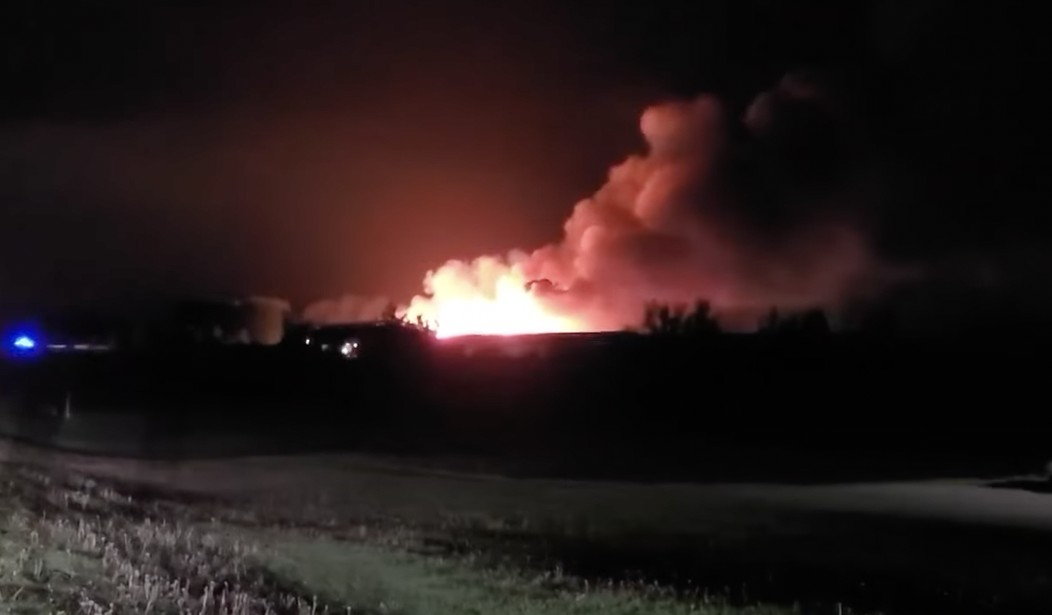Over the past several weeks, PJ Media has covered the growing number of food plants across America that have caught fire, exploded, or had planes crash into them. More food processing plants, and more industrial fires of note, have occurred since those reports.
As we reported on May 2:
To be crystal clear: no pattern has yet emerged. The incidents still appear random. Nobody has produced a connection between all these incidents.
There are just a LOT of them, and they’re continuing.
The FBI has not made any mention of the fires, plane crashes, and explosions, but it has issued an alert about cyberattacks possibly timed to disrupt the grain harvest season.
Well, in the subsequent month, several more incidents have occurred.
Last week, a large chicken processing facility burned in Minnesota, killing tens of thousands of chickens.
That came on the heels of another large chicken processing facility catching fire. On May 23, the Cargill plant in London, Ontario, suffered “significant damage” from a large fire over a holiday weekend.
Structure fire at 10 Cuddy Blvd, crews have knocked it down and are in the process of overhaul. Upon arrival heavy fire and smoke conditions that crews were able to knock down and gain access to extinguish the fire. #LdnOnt@LdnOntFire pic.twitter.com/EAjKtZ3o8x
— London Fire Department (@LdnOntFire) May 23, 2022
The plant employs about 700 people and processes a large number of chicken products for McDonald’s.
Somewhat related, over the Memorial Day weekend, a chemical plant in Omaha suffered several explosions and significant fire damage.
Jim Geraghty at National Review made the point that the number of such disasters hasn’t actually increased:
What we’re likely experiencing is the “Baader-Meinhof Phenomenon,” a.k.a. “frequency illusion” — when you hear a term and then feel like you’re suddenly seeing it everywhere. In reality, whatever you’re observing is occurring at the same frequency, it’s just that you didn’t notice it or ignored it before.
Because of the empty shelves earlier this year, people are paying much closer attention to supply chains these days. During the pandemic, many of us experienced sudden disruptions to our usually steady supplies of many varieties of food, as some meatpacking plants briefly shut down because of Covid outbreaks, and potato growers found it harder to get their spuds to consumers. (There was also that hacker attack on a major beef supplier in early 2021.) Then in January, tens of millions of Americans caught the Omicron variant at the same time, leading to disruptions to shipments of all kinds of products, and thus empty shelves and product shortages across the country. And those supply-chain problems still haven’t been worked out.
The National Fire Protection Association (NFPA), which PJ Media quoted in the May 2 article, has since examined the reports of food plant incidents to determine if a trend has emerged. NFPA reports:
The truth, however, is that nothing is unusual about any of the fires that have occurred in food processing plants over the first few months of the year. Although no data is kept on fires that occur strictly at food processing facilities, the National Fire Incident Reporting System tracks fires within broader categories like manufacturing, refrigerated storage, and agricultural facilities. In 2019, the number of fires at all manufacturing or processing plants in the country topped 5,300—nearly 15 a day. Additionally, more than 2,000 fires occurred in agricultural, grain and livestock, and refrigerated storage facilities, which could all include food processing operations.
Messerschmidt said food processing plants, like most industrial facilities, are prone to fires. “Food is fuel,” she said. “So as soon as you’re operating with food, you have something that is combustible.” On top of that, Messerschmidt added, you may have heat from cooking, high-pressure systems, combustible dusts, and other risk factors for fires and explosions present at these facilities.
While Messerschmidt hopes the focus on these fires will shift away from the conspiracy theories surrounding them, she said there is still value to examining what went wrong in particular incidents.
“We need to pay more attention to the fire protection measures that are in these facilities, make sure they’re maintained, and make sure they continue to function, so that when you are doing work in these kinds of plants you can make sure you control the risk that’s inherent,” she said.
NFPA probably could have avoided setting off more alarm bells with the title of its article — “Nothing To See Here” — and by not relying on the phrase “experts say” to make its point. But the point stands: there are lots of fires in America, and as PJ Media reported earlier, no trend has emerged.
Any number of factors could be at play, including the proclivity of fire to break out at these plants, supply chain stresses, deferred maintenance, and the possibility of insurance fraud and arson, which is hardly unheard of. We have also seen some high-profile cyberattacks, and the FBI has warned that more could be on the way.
So, while no trend has emerged, it’s still something to keep an eye on, and it continues to cause more stress on an already overburdened domestic food supply system.










Join the conversation as a VIP Member